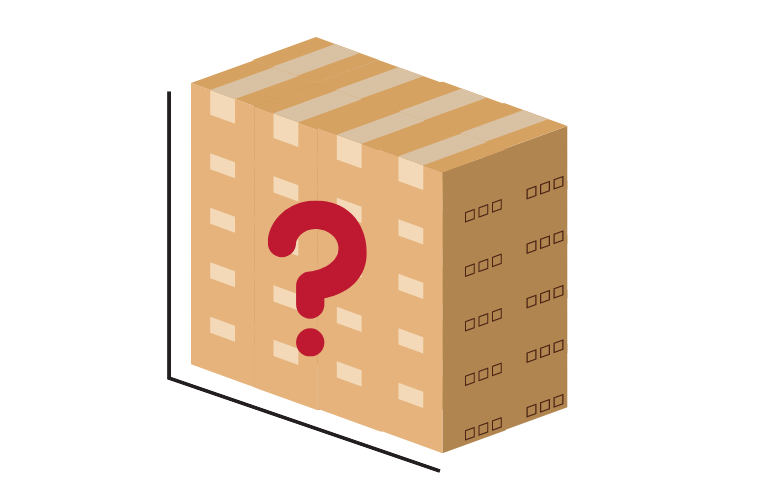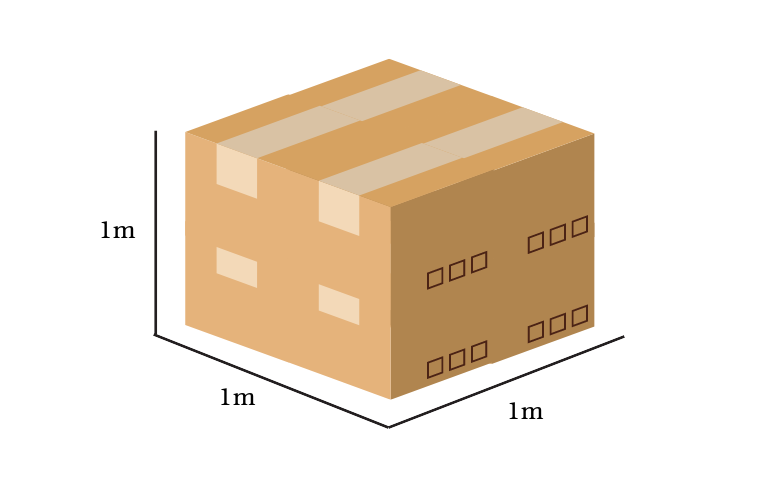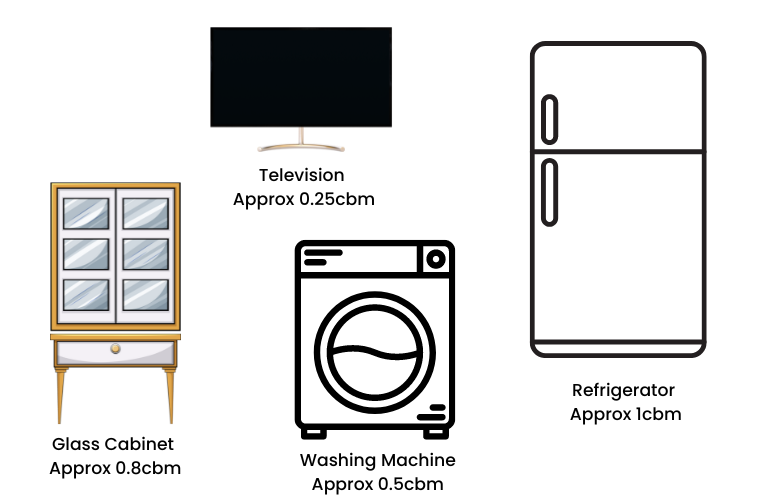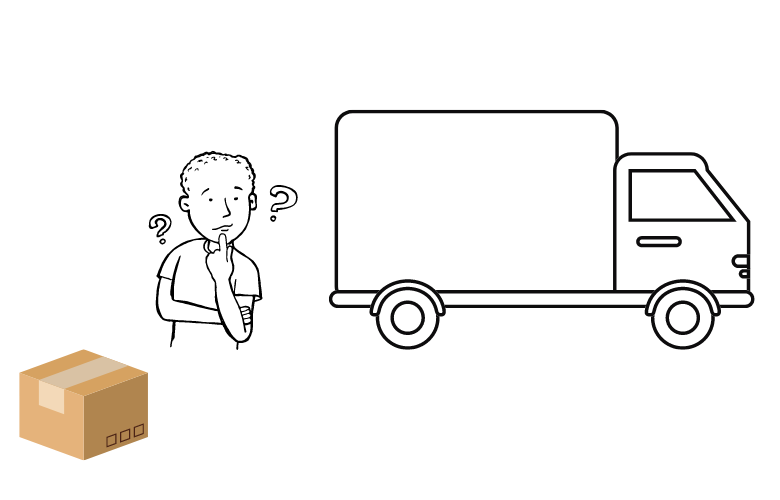Are you planning to move but always get confused when moving companies ask you the number of cubic meters you want to ship? Well, this question naturally becomes very important when these companies have to give you a relocation quote. Before we move ahead, let us provide insight into the meaning and definition of a Cubic Meter.
In this article, we have compiled the information and facts you need to know to measure your belongings accurately using a cubic meter while moving, which will eventually help you regulate the cost of your move. Read on to know!
What is a Cubic Meter?

If you wish to get the best deal when moving home, you must know about the phenomenon of a Cubic Meter. Short for “cubic meter” is CBM. A cubic meter may sound complex, but it isn’t. It is a unit that measures the volume of a cube. More specifically, it is a block of space (a cube) considered “perfect” because of its size. Since a cube’s length, height, and width is 1 Meter each; thus, its dimensions contribute to its perfect size. (For your information: I meter is about 3.28 feet.)
With a cubic meter, you can easily carry out the volume of any object you wish to move. When you multiply the height, length, and width, the resulting measurement will be in CBM.
Therefore, while moving, Cubic Meter will help you determine the size of the truck or a container you will require as per the volume of your objects.
Still confused?
You must have often heard that moving boxes also get calculated in Litres, right? Need not get confused! The conversion from Litres to Cubic meters is quite simple. The formula is “1000 liters is equivalent to 1 cubic meter.”
Know Why Using Cubic Meter While Moving Is Important For You!
By now, you should know how the use of cubic meters makes moving convenient for you and the moving company. The fact that movers use this phenomenon to ship your goods and also to provide you with a quote. If you are not aware of the cubic meter calculator, this can result in additional costs for your shipping goods.
Secondly, with the use of a cubic meter calculator, the movers will categorize the size of the container require to move your goods. Whether the container should be 20ft or 40ft can be carried out using cubic meters.
We know that the use of cubic meters or CBM helps in measuring the volume of a shipment. It establishes how much room your cargo will occupy on a ship, an aeroplane, or a truck, determining the transportation cost. So, get your home moving by estimating the volume using a cubic meter.
How Big Is A Cubic Meter?

Let us quote you 3 simple examples to explain the size of a cubic meter.
- Suppose you have a box of 50cm, then it will take 8 boxes of 50cm to make up for 1 cubic meter. 8 boxes of 50*50*50 = 1 cubic meter.
- As mentioned earlier, 1000 Litres is equal to 1 cubic meter. So, if you have a box of 50 Litres, it will take 20 boxes, each measuring 50 Litres, to make up for 1 cubic meter.
- In simpler words, approximately 8 medium to large boxes could determine the size of 1 cubic meter.
Measuring Volumes
The formula for calculating CBM is : Length x Width x Height = CBM
The use of cubic meters as a unit is used to measure the volume of any good item that can fit into that cube. This is also known as the volume of the cube. This fact can assist you in understanding the amount of sand to fill in a sandbox or the amount of cement you will need if you want to fill the patio in your backyard.
Getting back to the point now, how do we measure volumes? Well, it is nowhere similar to measuring a flat surface area. Instead, to calculate the volume, you will have to take the measurements of an object from all three sides: length, height, and width. Now, multiply the measurements together.
For instance, if you were to measure the volume of a swimming pool, you must first know the measurements of the swimming pool. If the swimming pool is 4 meters deep, 10 meters long, and 12 meters wide, the measurement in cubic meters will be carried out by multiplying them together. 4m*10m*12m = 480 cubic meters.
Checklist Of Popular Household Items In Cubic Meter!

We understand that packing your belongings to get them moved can be a tedious task. What adds more to it is not knowing the accurate measurement of your belongings. To make it more convenient for you to use the cubic meter while moving, we have compiled a list of a few standard household items (their measurement in cubic meters) that people generally carry. This list may help you imagine the sizes and number of boxes you need to experience hassle-free moving.
- Television – 0.25cbm
- Dining Table – 1cbm
- Dining chair – 0.15cbm
- Bedside table – 0.15cbm
- Standard Moving Box – 0.12cbm
- Washing Machine – 0.5cbm
- 2 seater lounge – 1.2cbm
- Glass Cabinet – 0.8cbm
- Chest of Drawers – 0.7cbm
- Refrigerator – 1cbm
**Note: These measurements may vary on the size of your items.
We believe now that moving anywhere in Australia has become much easier for you with the use of cubic meters. So the next time any mover asks you how many cubic meters you want to move, keep it handy and quote the cost per the volume of your goods that need to be shipped.
Conversions and Measurements
Here’s how to convert your cargo measures into meters because CBM is computed in meters:
- Centimetre to meter: Since 1 centimetre = 0.01 meter, convert a centimetre into a meter by multiplying by 0.01.
- Foot to meter: Since 1 foot = 0.3048 meters, so convert a foot into a meter by multiplying by 0.3048.
- Inch to meter: Since 1 inch = 0.0254 meters, convert an inch into a meter by multiplying by 0.0254.
Cubic Meter Calculator For Irregular Shaped Objects
So far, we have learned to calculate the CBM for regular-shaped packages, such as a cuboid or a cube. As mentioned, a carton has a regular shape, and its CBM can be calculated using the formula: Length*Width*Height. But how about those irregularly shaped packages? How do we calculate their CBM? Here is the answer to your question!
1- Cylindrical Package
Some packages are cylindrical, for example, a pipe or a rolled carpet. Put your package in an upright position and then measure the radius (that will be half of its diameter) and height. Keep in mind that the measurements will be in meters.
The formula is now π x r ² x h = CBM, wherein
- π (Pi) is conventionally equal to 3.14. It is in the proportion of a circle’s circumference to its diameter.
- H is the height (equivalent to the length.)
- R is Radius.
2- Irregularly Shaped Packages
To measure objects that don’t have any defining shapes or sizes, you will have to measure their (most extended) height, length, and width. The applied formula here will be:
Length (max) x Width (max) x Height (max) = CBM.
Pro Hacks To Save Your Money While Moving Home

The feeling of moving to your dream house is magical, and we know you must have been waiting for this moment for a long time. However, amidst the excitement of moving, you must take care of your expenses and budget. Using cubic meters while moving is an essential factor that influences your moving, but a few more can help you save even a little fortune of yours.
Develop A Move Strategy:
The most accurate and highly recommended way to save money is to have a move strategy handy before you move. No, it is not as over the top as it sounds, but it has assisted many people in saving money during the moving process. Keep everything handy, from acknowledging the volume of your stuff using a cubic meter calculator to booking your aeroplane tickets.
When you write these strategies on paper, you prepare a timeline for the future, which will help you stay on track. Wait, there’s more. A moving strategy will help you save money, and we will tell you how! When you have an organized plan to move, you can avoid the last moment irrational expenses that occur due to being unprepared.
Get Rid Of Unwanted Items:
When you start preparing to move, prepare a list of all the content lying in your house. Once the list is made, segregate the items you want to throw away. Make another list of things you want to move to the new home. Believe us, and you will realize that there would be several items that could be sold at a reasonable price, some of which can be donated or thrown away.
You will be surprised by how much your hard-earned money will be saved. In other words, you will not just get rid of the unwanted items but also secure more space for your wanted stuff that will fill your cubic meter while moving.
Book Your Move:
Experts recommend that around 8 to 12 weeks before your move, you should start exploring the options to book your trip. By having plenty of time, you can find a removal truck that is partially filled and adjust your belongings in the same truck. This factor is known as backloading, saving you a lot of money. Many removal companies in Australia want to utilize the space (left) in their containers and trucks. This is when these movers sell the remaining space at a lower price. You can find one such mover when you start looking 8 to 12 weeks before you move.
To sum up, having a strategy handy will not only help you in saving your money but also save you time and can mitigate a lot of last-minute panicking and frustration.
Some Cost Influencing Factors While Moving House
There are a plethora of factors that impact the cost while moving. As we have already discussed and understood, the volume of your goods plays a vital role in determining the time taken for packing your stuff and the number of removal vehicles required to move. However, some other factors are often overlooked but are equally important as knowing the volume of your belongings.
Firstly, the distance you travel is the prominent factor influencing the cost. It could be that the more there is, the more distance and time and fuel required will also be more. This will result in increasing your moving expenses.
The second factor is essential in accessing issues to your property. Moreover, breakable and delicate items like antiques, mirrors, vases, and more, usually take a long time to pack as they need to be handled very carefully. If your home is situated on the second or third floor then removalists will find it a little difficult to unload your goods for that reason they will take time to complete their task and which will eventually result in increased moving costs.
How Many Cubic Metres Can You Fit in one Moving Truck?

An approximate figure of cubic meters could fit in different containers or trucks. Let’s dig into the number of cubic meters that could fit in different sizes and shapes of containers.
- Bluey: This container can hold up to 2-6 cubic meters and has a maximum weight of up to 3.5 tonnes.
- End Tippers: There are 2 different trailers of this container. One of these containers can hold 8-tonne loads and about 18-20 cubic meters. The second type has around a 13-tonne load capacity and can hold up to 33 cubic meters.
- Walking Floor Trucks: This container can carry about 12 tonnes of load and nearly 35 cubic meters while carrying only “clean” products.
- True Blue: 24 tonnes load capacity, holding 80 cubic meters.
Final Words
The volume of the cube, also known as the quantity of material that can fit inside it, whether liquid or solid, is measured using cubic meters. After understanding the measuring parameters and cubic metres you can easily make an estimate of what will be your exact requirement to complete your move. So, move your house with the assistance of a cubic meter calculator and save yourself from burning a hole in your pocket.


